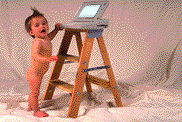Computer Underground Railroad Ent.
| Home | Lesson I | Lesson III | Lesson V |
| Cyber Parlor | Lesson II | Lesson IV | Moses |
| Einstein | King | Keys | Tapestry |
Lesson Three
Word Processing – Pt. 1
Computer Talk

Cyber Space – the nation of imagine where ideas are presented without regard to race, color or economic standing.
Files – a collection of related ideas (like a letter, report, computer instructions) that are held at the same address or location deep in the computer’s soul, the central processing unit.
Folders or Sub-Directory – Locations in the hard disk where you or MS-DOS have placed the work. The program Windows has its own folder. Lotus 123 does too. You can make folders in Windows Explorer which you will find on your start menu under programs. They make it easier to tell the computer what you want to be on by telling it where you put your work or games.
Disk Drive – Usually A= 3 ½” Floppy, C = Hard Disk, D = CD ROM
Programs – Thinking tools within folders that take your ideas and run them through a logical thought process.
Hard Disk – Located in your central processing unit, it holds all the information in a power on/power off format.
C:\> called C Prompt – The computer’s signal that you are talking to MS-DOS, the Microsoft Disk Operating System, the main traffic cop in your hard disk.
Saving a File – recording your work into the computer’s deep memory, the hard disk. Generally, click FILE, SAVE and give your work a name. DOS assigns folder unless you tell it different.
Icons – Pictures that represent different programs or files. Usually when you click and/or double click on an icon with a mouse, a program or feature runs on the computer.
Modem – A part of the computer, usually internal, that allows the computer to answer the phones, take messages, send faxes and files and, most importantly, get onto the Internet.
Software
Some of the ways the computer thinks with you
Word Processing – writing letters, reports, mass mailings, tables, flyers, books, etc. The word processor we are working with is Microsoft Word ’97.
Spreadsheets – numeric calculations (numbers presented) logically explained. Excel, Lotus 123, Project Manager.
Databases – used to sort large amounts of information (i.e. mailing lists and customer information.
Communications – helps your computer answer phones, take messages, send and receive faxes/e-mail and get onto the Internet.
Multi-media – makes your computer screen work like a television set – video, pictures, sound, CD’s, etc.
Graphics – programs with the emphasis on drawing or placing pictures or other images into what you’re working on. Graphics programs, including Harvard Graphics, PowerPoint and Corel Draw also allow you to turn your computer screen into a slide show stage.
Computer Aided Design CAD – style of programs that help in the design of anything from a room to an airplane. Used by many professions from gardeners to rocket engineers.
Office - Microsoft Office includes Word for word processing, Excel for spread sheets which which lays out numbers and charts in columns and rows, Access for managing a large amount of names, tasks, and other information (like index cards), Outlook for schedule and e-mail management, Photo Editor for taking pictures and making them look better, Front Page which lets you create your website using a simple format then translates your images into internet code, and Publisher that helps you make great flyers, invitations, etc.
Windows 3.1, 95, 98 and 2000 – programs by Microsoft that serve as a stage manager for what you se on the screen. Used to enter and exit many PC programs.
Internet – Think of Internet Software (AOL, Prodigy, Internet Explorer, Netscape, etc.) as your portal onto the Internet. It translates Internet language (Hyper Text Markup Language – HTML) into pictures, sounds and words.

Getting in and out of
the word processor
Entering
Windows 3.1
From the menu bar, click on WINDOW – MICROSOFT OFFICE- MICROSOFT WORD. Then double click on MICROSOFT WORD’s icon (picture)
WINDOWS ‘95
Click on START. Then move your mouse pointer to PROGRAMS. Staying within the color surrounding the word PROGRAMS, move your mouse straight across to the words MICROSOFT WORD. Click on MICROSOFT WORD.
EXITING
Save your work by clicking on either the SAVE button (which looks like a small 3 ½ inch floppy disk. Then click on FILE – EXIT.
Or if you’ve already saved your work -
Click on the menu bar
FILE - EXIT
If you have unsaved work, it will ask you if you want to save it. If so, click on YES, give your file a name and change the location if you want to, then click O.K.
Another way to exit a program is by using the close button on the Title Bar. The close button is located on the far right hand side of the top bar and is marked with the letter X. If you click on the X the entire program will close.
Before it turns itself off, if some information has been entered since the last time the document was saved, it will ask you if you want to save it. Decide for yourself.
Practice Material
|
Lesson I Write by hand your response |
Lesson II Write/Speak Your Thoughts |
Lesson III Type Notes Into Word |
|
Lesson IV Replicate The Layout- |
Lesson V Replicate The Layout - |
Ergonomics Made Simple Comfortable Computing |
Organizational Material
|
|
|
|
Proposal & How To Set Up Training |
How To Compute Study Notes |
|
|
|
|
Microsoft |
Microsoft |
HOW
TO COMPUTE
CLASS NOTES AND MATERIAL BY:
J. Nayer Hardin, Founder
Computer Underground Railroad Enterprises (C.U.R.E.)
C.U.R.E.
Website: http://www.compurest.com
E-mail: [email protected]
The cost of using this material is that
the knowledge be passed onto at least two other people.
Published 1994-Present
ALL RIGHTS RESERVED